Looking for sublime midrange detail through the entire passband where almost all of the fundamentals lie...what's your goto?
Hi,
that's quite wide bandwidth, have you looked into planars?
I have no experience on this so sorry posting so quick here. As it was interesting quickly tried ideal ~3" woofer on VCAD diffraction sim, which is about biggest one you can use if you want to avoid diffraction on the pass band. This means bottom of the pass band is about 15db down and limits your system SPL.
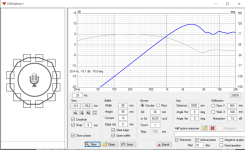
If you increase baffle size, and/or driver size, to get more sensitivity on lows edge diffraction is now on pass band.
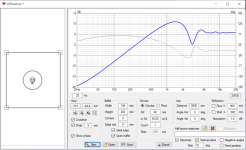
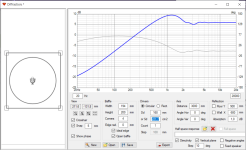
Perhaps tall but narrow planar would have more output capability without making edge diffraction into pass band.
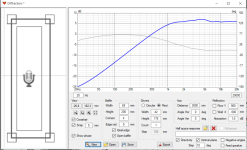
Of course array could work as well.
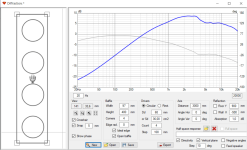
ps. cheez prices have gone up. tc9fd is almost 40€, or ss 10f about 100€! I think tc9fd was about 10€ five years back when I bought few, quite mad currency debasement.
that's quite wide bandwidth, have you looked into planars?
I have no experience on this so sorry posting so quick here. As it was interesting quickly tried ideal ~3" woofer on VCAD diffraction sim, which is about biggest one you can use if you want to avoid diffraction on the pass band. This means bottom of the pass band is about 15db down and limits your system SPL.

If you increase baffle size, and/or driver size, to get more sensitivity on lows edge diffraction is now on pass band.


Perhaps tall but narrow planar would have more output capability without making edge diffraction into pass band.

Of course array could work as well.

ps. cheez prices have gone up. tc9fd is almost 40€, or ss 10f about 100€! I think tc9fd was about 10€ five years back when I bought few, quite mad currency debasement.
Eminence Beta8 is about the best OB midrange I've heard. Can easily be crossed at 350 and 5kHz. Super clean, well behaved, great tonality.
It doesn't look like much, but it's a surprisingly good driver and easy to get right. (that's important)
https://www.madisoundspeakerstore.com/special-sale/eminence-beta-8-8-pro-mid-bass-8-ohm/
That's a heck of a good price at the moment.
The Seas Prestige FA22RCZ is also very good as an OB mid. Pricey, but a good driver.
https://www.madisoundspeakerstore.com/approx-8-fullrange/seas-prestige-fa22rcz-h1597-08-8-fullrange/
There was another 8" woofer that I liked on OB, maybe Peerless of ScanSpeak - light color cone. Meant as a replacement in old AR speakers, IIRC. I'll have to do some searching.
It doesn't look like much, but it's a surprisingly good driver and easy to get right. (that's important)
https://www.madisoundspeakerstore.com/special-sale/eminence-beta-8-8-pro-mid-bass-8-ohm/
That's a heck of a good price at the moment.
The Seas Prestige FA22RCZ is also very good as an OB mid. Pricey, but a good driver.
https://www.madisoundspeakerstore.com/approx-8-fullrange/seas-prestige-fa22rcz-h1597-08-8-fullrange/
There was another 8" woofer that I liked on OB, maybe Peerless of ScanSpeak - light color cone. Meant as a replacement in old AR speakers, IIRC. I'll have to do some searching.
Only three octaves really so i felt it reasonable. i don't think a 3-4" mid is gonna cut it on the power handling front.....the 10f ......maybe?Hi,
that's quite wide bandwidth, have you looked into planars?
I have no experience on this so sorry posting so quick here. As it was interesting quickly tried ideal ~3" woofer on VCAD diffraction sim, which is about biggest one you can use if you want to avoid diffraction on the pass band. This means bottom of the pass band is about 15db down and limits your system SPL.
View attachment 1264522
If you increase baffle size, and/or driver size, to get more sensitivity on lows edge diffraction is now on pass band.
View attachment 1264527View attachment 1264526
Perhaps tall but narrow planar would have more output capability without making edge diffraction into pass band.
View attachment 1264528
Of course array could work as well.
View attachment 1264530
ps. cheez prices have gone up. tc9fd is almost 40€, or ss 10f about 100€! I think tc9fd was about 10€ five years back when I bought few, quite mad currency debasement.
The Eminence is pretty smooth with the benefit of uber low distortion given it's a pro sound driver. I worry about the directivity mismatch at 3khz though....unless i go planar tweeter........that pattern might just match up at 3.5. Hmmmmmm
I did hear them with a Planar tweeter crossed 1st order at 5K. All you need on the Beta8 is a 0.5mH coil in series to flatten out the top end. Use its natural roll-off on the top.
Later the person with the system went with horn tweeters which he liked for better dynamics. I didn't hear that version.
If I were currently building an OB I'd jump on the Beta8 at the sale price. Perhaps it won't be where you end up, but it's a driver that is easy to use and sound super clean. Hard to find a better starting point or reference for an OB mid.
Later the person with the system went with horn tweeters which he liked for better dynamics. I didn't hear that version.
If I were currently building an OB I'd jump on the Beta8 at the sale price. Perhaps it won't be where you end up, but it's a driver that is easy to use and sound super clean. Hard to find a better starting point or reference for an OB mid.
Your sims only look at the on-axis response. That is a major mistake. For example for the sim of the small driver in a square baffle where the on-axis dip is located is where off axis responses rise, so all together the responses pinch and even cross in some cases. This messes up the pattern/directivity. The smoothest (and therefore best) response through and above the dipole peak is obtained with a nude driver. I published a paper in AudioXpress on this last year with lots of technical analysis that comes to this conclusion. Also, the sonic signature of a large baffle is detrimental to the sound of the speaker in the room IMO, which is another reason to use a nude midrange - it keeps the physical size and acoustic footprint of the speaker small.
As far as drivers are concerned, for drivers with cones 3.5kHz is a bit too high for most. In fact smaller drivers like the SS 10F are very bad up there as a dipole. If you can accept 2kHz then there are some that will work well, but then getting them to play well nude down low becomes a problem due to losses. A driver around 6" to 7" can work, but I have done measurements on many of them and there is often problematic behavior on and off axis just above the dipole peak, which would be around 1.5kHz in this case.
The best drivers for very wide band operation are not cheap:
Satori MW19TX
Purifi PTT6.5M
But if you want a cheaper alternative:
SB Acoustics SB17MFC
I have used all of these drivers in different systems, as nude midranges. The SB17MFC is able to be used higher than the other two, but has worse distortion performance (still not bad!) and cannot go as low. The Purifi driver is excellent all around. The Satori is slightly larger and I have been able to use it down as low as 200Hz when crossed over steeply (I use DSP) and up to 2kHz. All three can definitely work down to 350Hz when nude without a problem.
As far as drivers are concerned, for drivers with cones 3.5kHz is a bit too high for most. In fact smaller drivers like the SS 10F are very bad up there as a dipole. If you can accept 2kHz then there are some that will work well, but then getting them to play well nude down low becomes a problem due to losses. A driver around 6" to 7" can work, but I have done measurements on many of them and there is often problematic behavior on and off axis just above the dipole peak, which would be around 1.5kHz in this case.
The best drivers for very wide band operation are not cheap:
Satori MW19TX
Purifi PTT6.5M
But if you want a cheaper alternative:
SB Acoustics SB17MFC
I have used all of these drivers in different systems, as nude midranges. The SB17MFC is able to be used higher than the other two, but has worse distortion performance (still not bad!) and cannot go as low. The Purifi driver is excellent all around. The Satori is slightly larger and I have been able to use it down as low as 200Hz when crossed over steeply (I use DSP) and up to 2kHz. All three can definitely work down to 350Hz when nude without a problem.
Last edited:
I wouldn't recommend tc9fd. At first, it sounds smooth and nice but then... Lifeless and mushy. For $10 maybe it can pass, but not more. Just my opinion. Also, the low efficiency limits overall system efficiency.
I'd go with at least 6.5" or even 8" wide range speaker...
I'd go with at least 6.5" or even 8" wide range speaker...
I like this one. Your upper cross point is a little higher than I'd prefer for it, but still probably doable with some crossover finesse:
Scanspeak 15W/8434G00
https://www.madisoundspeakerstore.c...anspeak-15w/8434g00-discovery-5.25-midwoofer/
Scanspeak 15W/8434G00
https://www.madisoundspeakerstore.c...anspeak-15w/8434g00-discovery-5.25-midwoofer/
What you're suggesting is a 4 way then.....and kinda where Linkwitz landed with the 521 and an 8" midwoofer to 1khz and then handed off. I gotta say if i were to go that route, i'm not crossing anywhere between 1-3k. Domes are out for the obvious dipole reasonYour sims only look at the on-axis response. That is a major mistake. For example for the sim of the small driver in a square baffle where the on-axis dip is located is where off axis responses rise, so all together the responses pinch and even cross in some cases. This messes up the pattern/directivity. The smoothest (and therefore best) response through and above the dipole peak is obtained with a nude driver. I published a paper in AudioXpress on this last year with lots of technical analysis that comes to this conclusion. Also, the sonic signature of a large baffle is detrimental to the sound of the speaker in the room IMO, which is another reason to use a nude midrange - it keeps the physical size and acoustic footprint of the speaker small.
As far as drivers are concerned, for drivers with cones 3.5kHz is a bit too high for most. In fact smaller drivers like the SS 10F are very bad up there as a dipole. If you can accept 2kHz then there are some that will work well, but then getting them to play well nude down low becomes a problem due to losses. A driver around 6" to 7" can work, but I have done measurements on many of them and there is often problematic behavior on and off axis just above the dipole peak, which would be around 1.5kHz in this case.
The best drivers for very wide band operation are not cheap:
Satori MW19TX
Purifi PTT6.5M
But if you want a cheaper alternative:
SB Acoustics SB17MFC
I have used all of these drivers in different systems, as nude midranges. The SB17MFC is able to be used higher than the other two, but has worse distortion performance (still not bad!) and cannot go as low. The Purifi driver is excellent all around. The Satori is slightly larger and I have been able to use it down as low as 200Hz when crossed over steeply (I use DSP) and up to 2kHz. All three can definitely work down to 350Hz when nude without a problem.
What bothers you about the SS 10F at 3.5?.......bad in what way?
Hi,Your sims only look at the on-axis response. That is a major mistake. For example for the sim of the small driver in a square baffle where the on-axis dip is located is where off axis responses rise, so all together the responses pinch and even cross in some cases. This messes up the pattern/directivity. The smoothest (and therefore best) response through and above the dipole peak is obtained with a nude driver. I published a paper in AudioXpress on this last year with lots of technical analysis that comes to this conclusion. Also, the sonic signature of a large baffle is detrimental to the sound of the speaker in the room IMO, which is another reason to use a nude midrange - it keeps the physical size and acoustic footprint of the speaker small.
yeah the dipole peak is due to diffaction, and about the same if it was a boxed speaker with same sized baffle. Boxed speaker has bit less of a hump as it is just edge diffraction backwave that makes it. OB has sound diffracting also from backside magnifying it further. Looking at on axis data is enough in this case if one knows about edge diffraction and cone breakup and such, but you are right there would be more knowledge available with full polars.
Clean pattern is below the peak, and above it's not, same with boxed speakers. This means good bandwidth is from the peak down with boxes or OB. Going beyond is fine of course but not optimal and better to avoid if possible. Same reasoning results minimal baffle is best for boxed drivers as well (edge close to driver if there is any) . And that nude driver provides most SPL capability for the useful bandwidth in OB.


I'd bet that the basket and magnet obscures relatively much, also the radiating area is quite much less behind, perhaps something else, all breaking the pattern.What bothers you about the SS 10F at 3.5?.......bad in what way?
Hence planar 😉
if experienced say bigger woofers are fine then they likely are. My stuff here is mostly from sims and assuming ideal stuff, not considering how they would actually sound like in reality.
Last edited:
6.5" does seem like a sweet spot of a big system midrange. But I can confirm that 8" also works well, at least on OB. No power response issues as far as I could tell, quite the contrary. I've even heard the old Beta12LT as an open baffle mid and it was stunning. Light and clean, super resolved and sounding a like an electrostatic speaker with more dynamics. I was shocked. Very tricky crossover though, circa 6K. It's not well behaved at the top.
I once built a big OB test sled with twin 15s and a cutout and adapter so that I could run any 6-8" mid or fullrange I wanted in there. New, vintage, cheap or expensive. They all sound different, many don't sound great. ;(
I once built a big OB test sled with twin 15s and a cutout and adapter so that I could run any 6-8" mid or fullrange I wanted in there. New, vintage, cheap or expensive. They all sound different, many don't sound great. ;(
I'm using the Beta 8a nude OB from about 400 - 1500, crossing to a nude 15" at the bottom, and the big Heil AMT at the top. The Heil does a lot of the heavy lifting, it has the range cross low enough to meet the dipole peak of the 8" mid. I tried the SB17CAC as a mid, but it seemed a waste to cross the Heil at 2k, and the SB struggled to go low enough to meet the big woofer. I'm not quite as fussed as Charlie about absolutely perfect polars (though I fully respect his search for perfection) but the system sounds good to me.
Bill
Bill
Betsy?Looking for sublime midrange detail through the entire passband where almost all of the fundamentals lie...what's your goto?
The B&C 8pe21 is the best sounding large mid i've ever used (we use it in our arrays) and if what Charlie mentions about the dipole peak is true , the response dip of the B&C would get filled in quite nicely!
https://www.parts-express.com/pedocs/specs/294-652--bc-8pe21-spec-sheet.pdf
https://www.parts-express.com/pedocs/specs/294-652--bc-8pe21-spec-sheet.pdf
This driver has a stamped steel basket that is somewhat "closed". I would be concerned about what is going on with the rear output around 1kHz and above. For OB and dipole systems this is just as important as what comes out the front of the cone. Sometimes these drivers have some pathological resonances that form inside the basket. Have you used this driver or measured its rear response?SBAudience Bianco-8MW125
For better directivity at the top end of your desired range, a driver smaller than 8" is better suited. The Satori MW16TX Textreme would certainly give you lots of great detail, though even this driver starts beaming >3kHz. Haven't look at the effect of the basket & magnet (more open & smaller than most) on the rear directivity. @CharlieLaub might have examined this?
I have been using an 8 inch driver on open baffle from 150Hz up to 3,5kHz for almost 20 years with a 0.5 helper woofer from 150Hz to 300Hz . Lot's of other drivers of differenct sizes have come by but 8 inch is my preferred size in this range. Beaming is much less of an issue than the same size driver in a closed or reflex cabinet because beaming is nothing more than the difference in directivity between the lower end and the upper end and since open baffle speakers have a more narrow directivity at the bottom to begin with the upper end can be more extended. A driver with no or clean breakup in this passband that is good up to 1500Hz in a closed box can easily go up to 3kHz on open baffle. Drivers with very open baskets are preferred though.
For better directivity at the top end of your desired range, a driver smaller than 8" is better suited. The Satori MW16TX Textreme would certainly give you lots of great detail, though even this driver starts beaming >3kHz. Haven't look at the effect of the basket & magnet (more open & smaller than most) on the rear directivity. @CharlieLaub might have examined this?
I gave the MW13P a try once, but when measured from the rear the response was not good above 1.5kHz, which was a bit too low for such a small driver. But with the larger MW19TX it was fine. I have found that if you actually make high resolution measurements to the rear you find all sorts of messes with most drivers. When you put the driver in a large baffle that is less of a concern, but that is not the sort of construction I prefer.
I have measured the Vifa TG9, The ScanSpeak 10F, as well as many drivers in the 5-8" range and found flaws in the rear response of most of them. But I am picky about the sort of responses I want to work with.
At the other end of spectrum, it is possible to use some very large drivers nude when the basket is very open. I used an Eminence Deltalite 2515 (a 15" driver) crossed over at 1.6kHz in a project a few years ago. I was shocked that the driver had a good pattern when seen from both the front and rear up to about this point (that quickly broke down above there). I used it as a large midrange and in that role it was pretty good for that sort of driver! Compared to the cone area, the motor was very small and the basket is VERY open. Like @Sjef mentions, there is less variation from low to high frequency for a dipole type application.
- Home
- Loudspeakers
- Multi-Way
- 350hz to 3.5khz open baffle......what driver would you choose?